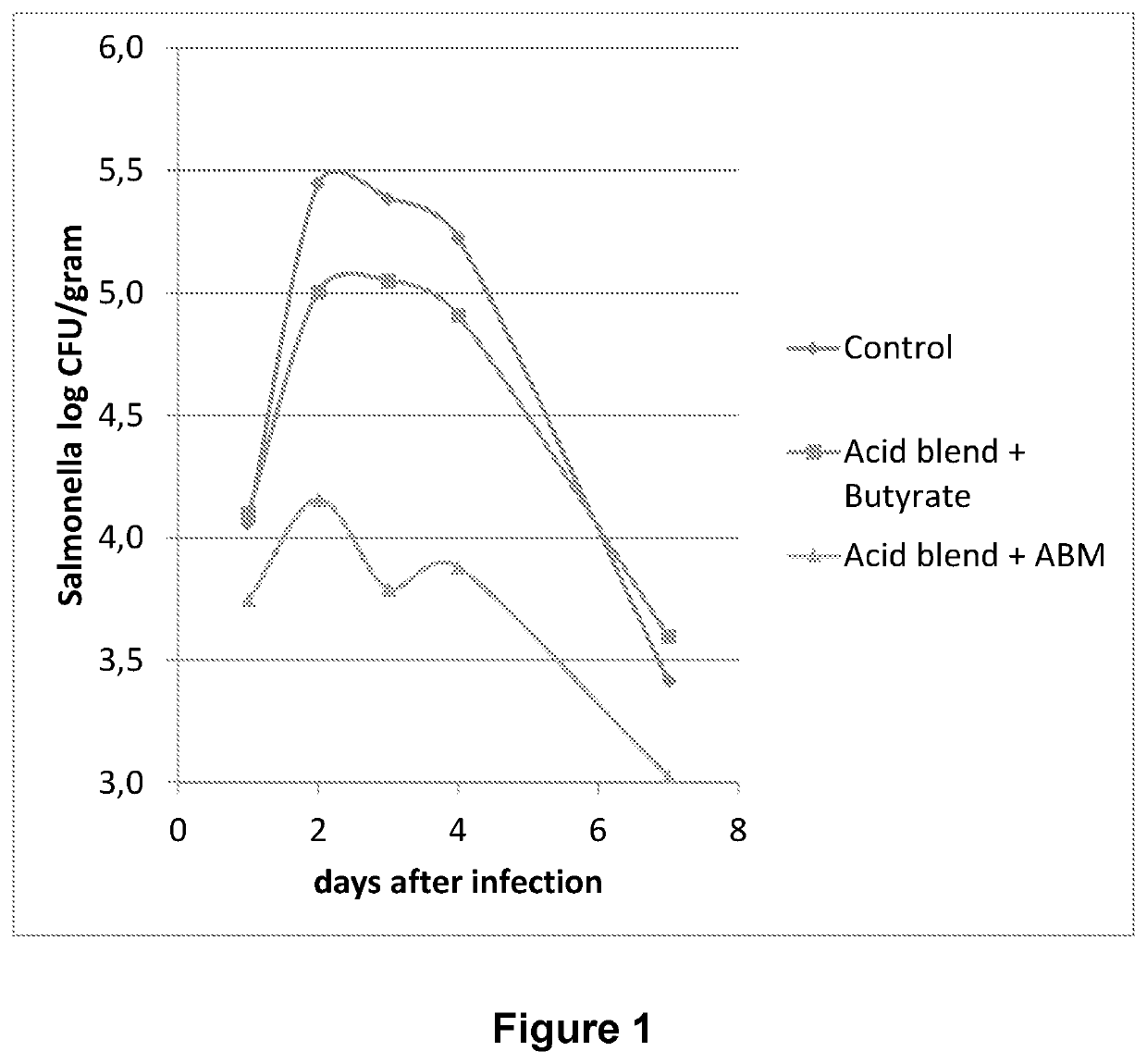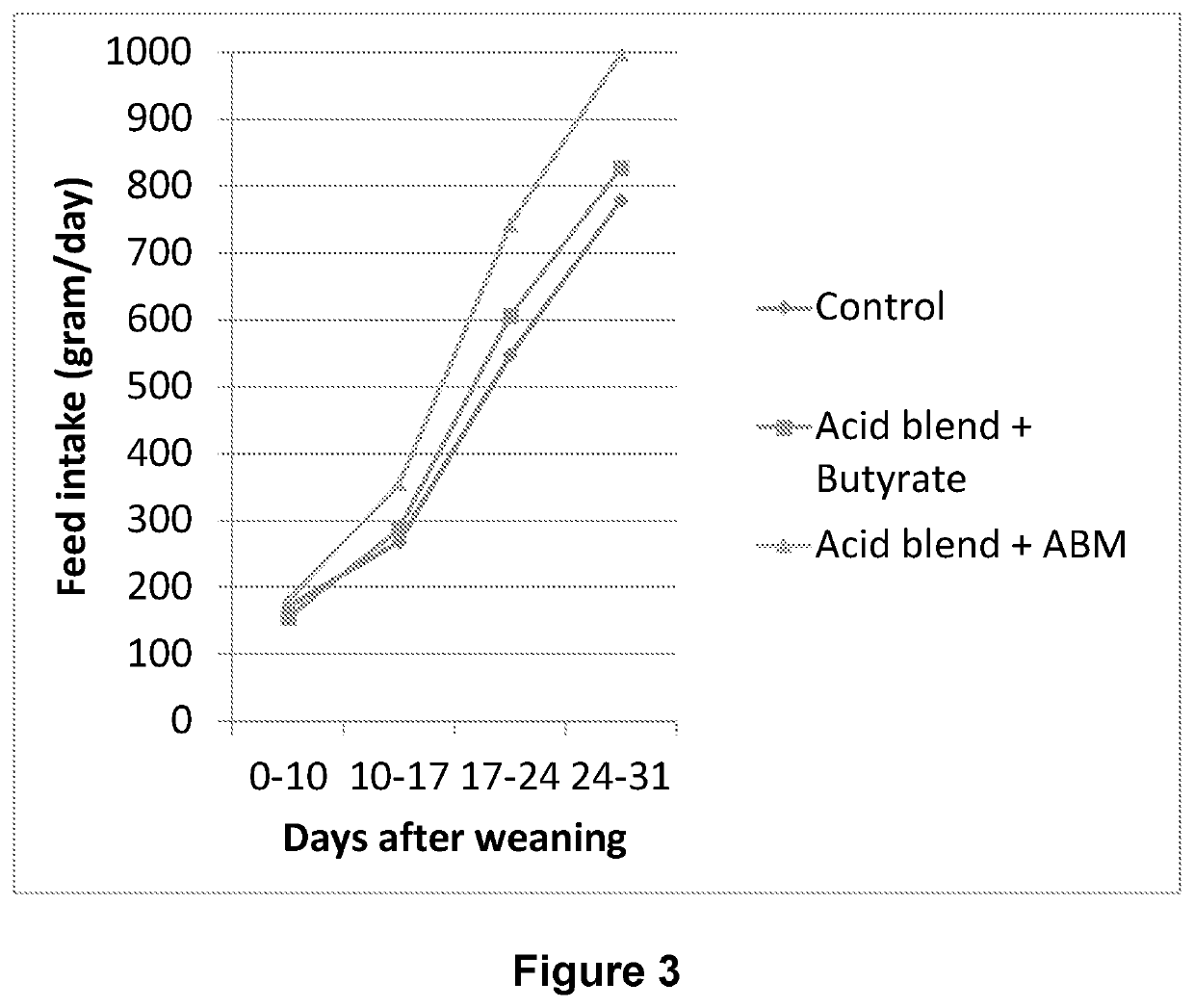A method of feeding monogastric animals in order to control the presence of bacteria in these animals
a monogastric animal and bacteria technology, applied in the field of controlling the presence of bacteria, can solve the problems of not being suitable for raising pigs or poultry for consumption purposes, and achieve the effect of reducing the amount of bacteria and reducing one or more negative effects
- Summary
- Abstract
- Description
- Claims
- Application Information
AI Technical Summary
Benefits of technology
Problems solved by technology
Method used
Image
Examples
example 1
[0036]Example 1 describes an in vitro model study for assessing the effect of ABM mycelium on bacterial adhesion. In this method the adhesion of Salmonella typhimurium to ABM mycelium is assessed.
[0037]Use was made of a 96-well plate on which the ABM mycelium was coated. For this, the ABM mycelium (in this and each case below a fermented rye product was actually used, in which product the amount of ABM mycelium was about 15% w / w) was suspended in PBS to a final concentration of 1% (w / v) and mixed thoroughly. Subsequently the suspension was centrifuged to remove insoluble material. Thereafter, the supernatant was used for coating the wells of the microtiter plate. For the adhesion assessment, a Salmonella typhimurium suspension was added to the microtiter plate. The plate was then incubated for 30 minutes and after this incubation step washed with PBS. Subsequently growth medium was added to the wells and the time to onset OD600 value was determined. The optical density (OD) measurem...
example 2
[0041]Example 2 describes an in vivo study for assessing the effect of ABM mycelium on bacterial shedding. In this study it was assessed whether the effect on adhesion seen in vitro (see Example 1) corresponds to in vivo bacterial shedding, and thus inherently, to in vivo spreading of the bacterium in a herd of pigs. In particular, it was assessed whether by introducing ABM mycelium in the feed of the pigs, the shedding of viable bacteria could be reduced. As controls, a negative control using the regular feed was used, and as a positive control the same feed with added butyrate, a particular short chain fatty acid that is commercially used in poultry feed to reduce bacterial shedding. Apart from the feed received by the negative control animals, all feed was topped up with a regular C1-C16 organic acid blend containing a combination of formic and lactic acid at 4 liters per 100 kg to reduce microbial growth in the feed itself.
[0042]A total of 24 Topi*Hypor boar piglets were used. O...
example 3
[0049]Example 3 describes a second in vivo study for assessing the effect of ABM mycelium on bacterial shedding. In this study, as a positive control the acid blend was use, in order to assess the additional effect of ABM mycelium.
[0050]A total of 36 Topi*Hypor boar piglets were used. Only healthy male animals that did not receive antibiotics and that were negative for Salmonella (determined by qualitative examination of the feces) were included in the study. Animals were identified by uniquely numbered ear tags. Animals were divided over three groups (12 animals per group) by weight and litter.
[0051]Piglets were individually housed (0.8×0.8 m) directly after weaning (24 days of age+ / −3 days) in pens containing tenderfoot slatted floors. The first 24 hours after weaning continuous light was provided, thereafter 16 hours light and 8 hours darkness. Piglets received feed and drinking water ad lib. The different treatments were administered in the feed during the total study period (fr...
PUM
 Login to View More
Login to View More Abstract
Description
Claims
Application Information
 Login to View More
Login to View More - R&D
- Intellectual Property
- Life Sciences
- Materials
- Tech Scout
- Unparalleled Data Quality
- Higher Quality Content
- 60% Fewer Hallucinations
Browse by: Latest US Patents, China's latest patents, Technical Efficacy Thesaurus, Application Domain, Technology Topic, Popular Technical Reports.
© 2025 PatSnap. All rights reserved.Legal|Privacy policy|Modern Slavery Act Transparency Statement|Sitemap|About US| Contact US: help@patsnap.com



